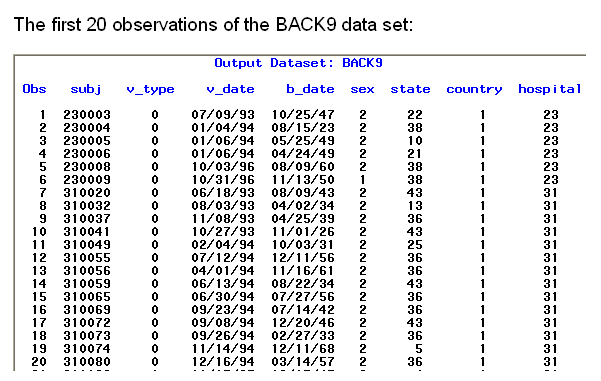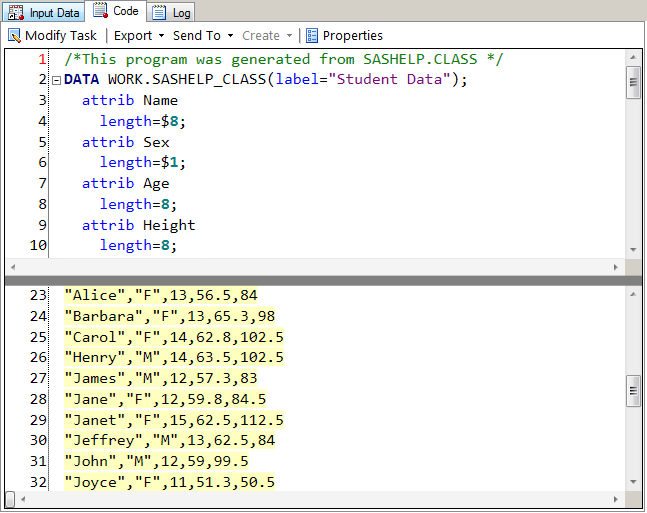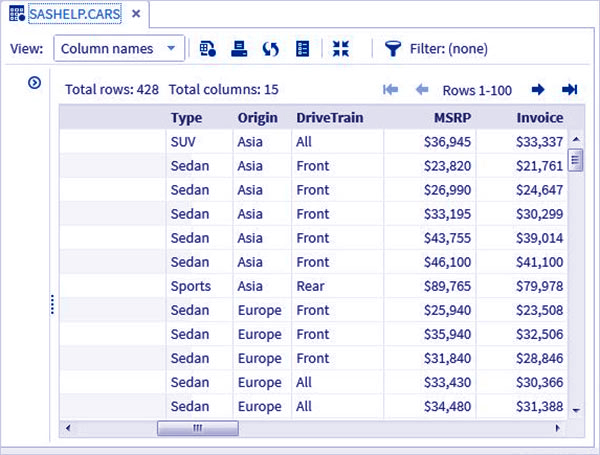
Créer une table SAS (dataset) type Pour débuter créons un data set (table SAS) appelée POP avec colonnes START, LABEL, TYPE et FMTNAME. Cette table contient les données pour deux formats : un format numérique et un format alphanumérique. Ces deux formats sont appelés GRP. It is created using the DATA step.

SAS can read a variety of files as its data sources like CSV, Excel, Access, SPSS and also raw data. It also has many in-built data sources available for use. Definition of a SAS Data Set. INPUT reads raw data from an external file or from in-stream data lines in order to create SAS variables and observations.
For example, the data set lists sales001–salesand sales01–salescause an error. If the numeric suffix of the first data set name does not contain leading zeros, the number of digits in the numeric suffix of the first and last data set names do not have to be equal.
The data set list sales001–sales9is valid. Pour créer un data set SAS de but en blanc, il est possible de saisir des données manuellement ou de lire un fichier. TXT dans une étape DATA.
Selon la structure des données approches sont envisageables de manière distincte ou en combinaison. Lorsque chaque observation est séparée par des espaces, on parle de l’approche LINE INPUT.

Les métadonnées (metadata) peuvent se présenter sous la forme de tables SAS (data sets). Elles donnent une description d’une table SAS. To create a SAS view instea use the VIEW= option in the DATA statement.
With a SAS view you can, for example, process monthly sales figures without having to edit your DATA step. Whenever you need to create output, the output from a SAS view reflects the current input data values.
Ajouter des lignes à un data set en utilisant celles d’un autre data set, c’est possible avec SAS. Selon les particularités du data set, une ou plusieurs méthodes sont disponibles. Trois data sets en fin d’articles sont disponibles pour tester les différentes méthodes. Use the WHERE= data set option with an input data set to select observations that meet the condition specified in the WHERE expression before SAS brings them into the DATA or PROC step for processing.
Selecting observations that meet the conditions of the WHERE expression is the first operation SAS performs in each iteration of the DATA step. The Data Sets are called temporary Data Set if they are used by the SAS program and then discarded after the session is run. Usually, the DATA statement specifies at least one data set name that SAS uses to create an output data set.
However, when the purpose of a DATA step is to write a report or to write data to an external file, you might not want to create an output data set. Using the keyword _NULL_ as the data set name causes SAS to execute the DATA step without writing observations to a data set. SAS does not create an output data set.
If you do not specify a name for the input data set in a SET statement, SAS automatically uses the last data set that was created. SAS data set is a SAS file, which holds data. SAS keeps track of the most recently created data set through the reserved name _LAST_. When you execute a DATA or PROC step without specifying an input data set, by default, SAS uses the _LAST_ data set.
Example 1: Describing a SAS Data Set. Features: PROC CONTENTS statement options: DATA = OUT= Other features: OPTIONS statement. SAS– Statistical Analysis System – est un logiciel complet qui couvre une large gamme des méthodes d’analyse en Statistique.
This example shows the output from the CONTENTS procedure for the Cars table. Identifier et supprimer les doublons dans un data set fait partie des compétences de base du programmeur SAS.
Trois approches sont envisageables : PROC SQL, PROC SORT et un compteur dans un data step. On the Data tab, select SASHELP. CLASSFIT as the input data set.
Je cherche à empiler tables de même structure par macro.

Aucun commentaire:
Enregistrer un commentaire
Remarque : Seul un membre de ce blog est autorisé à enregistrer un commentaire.